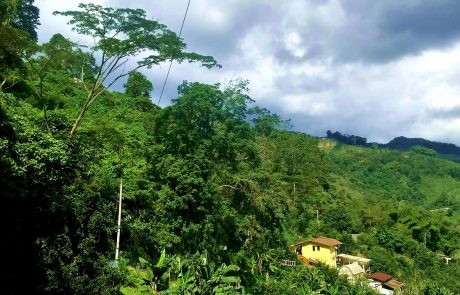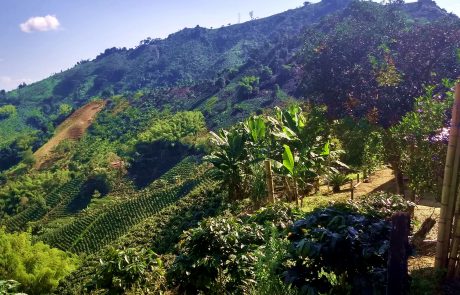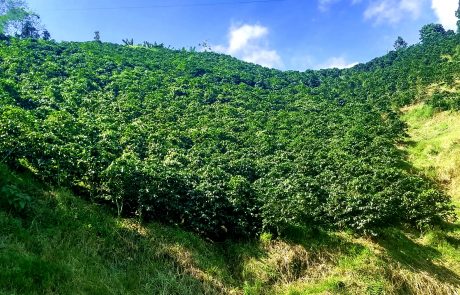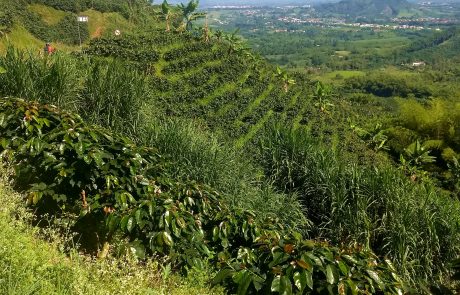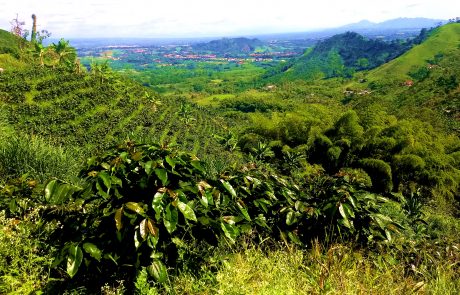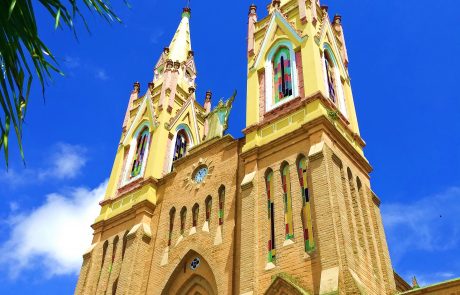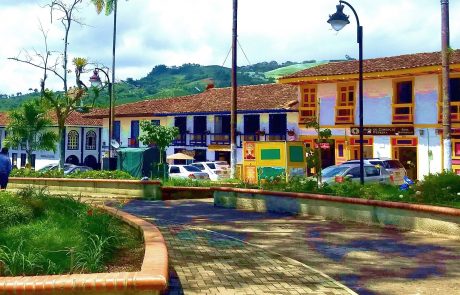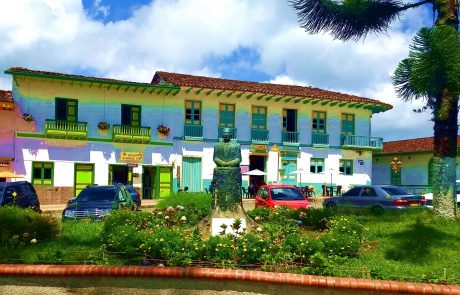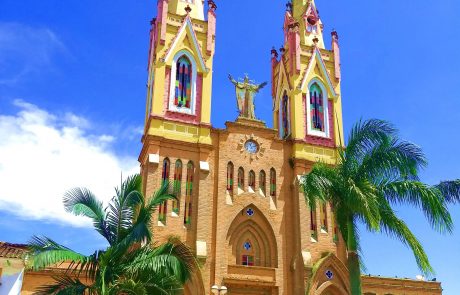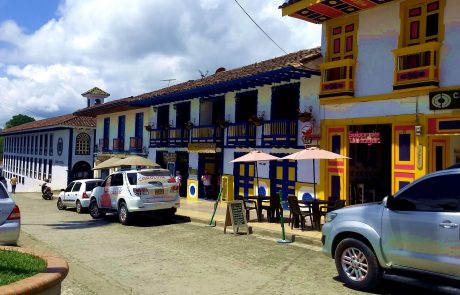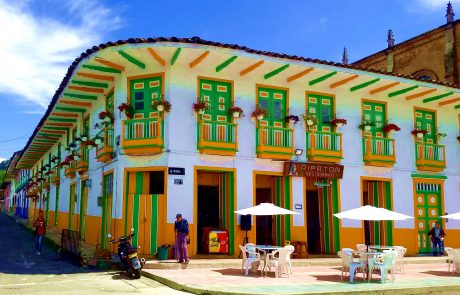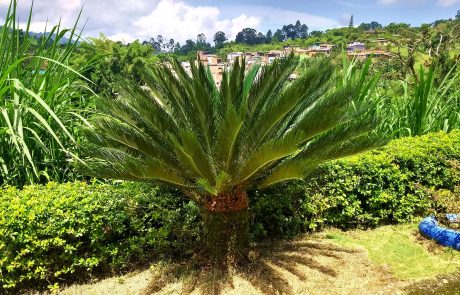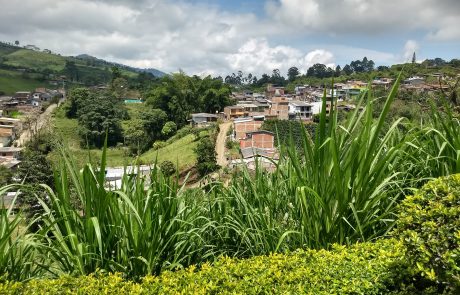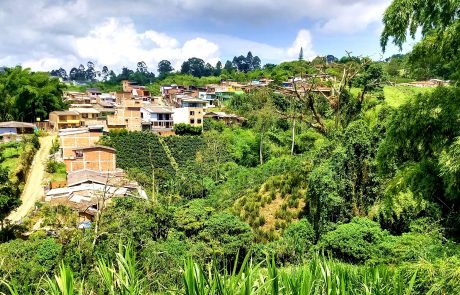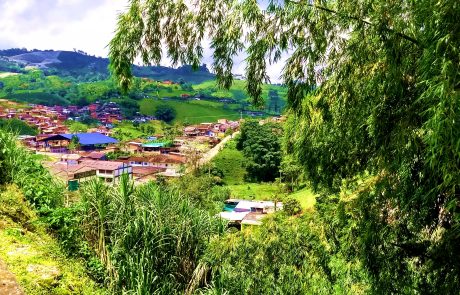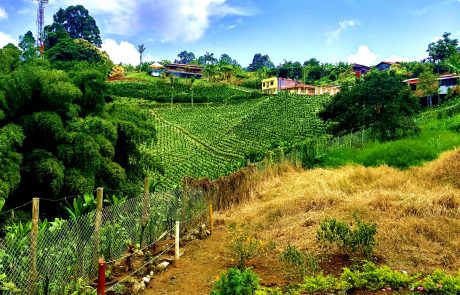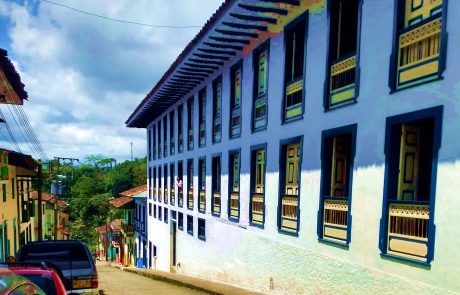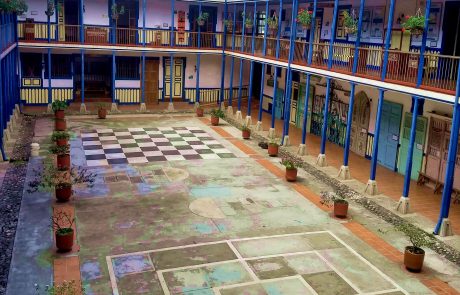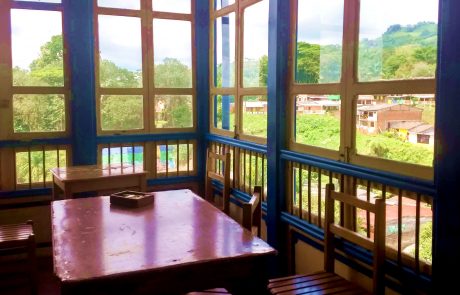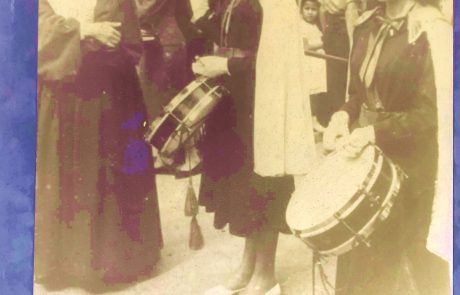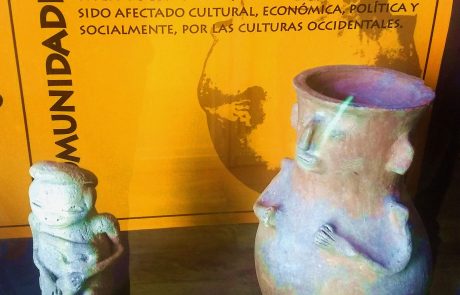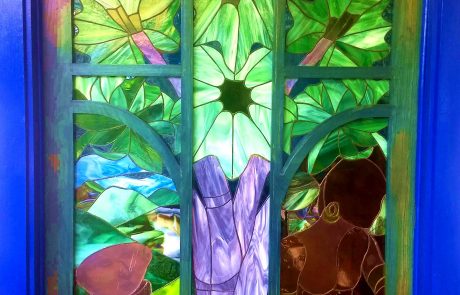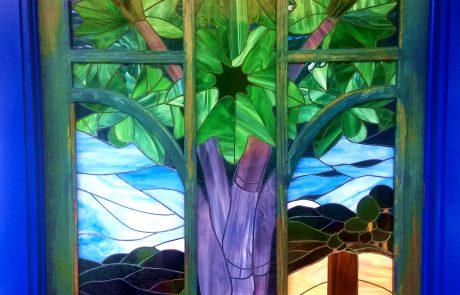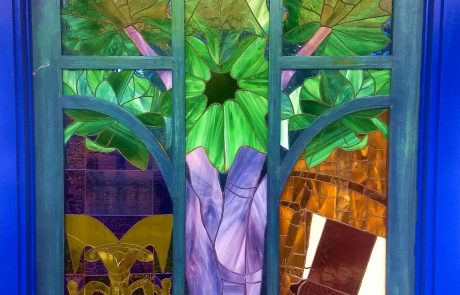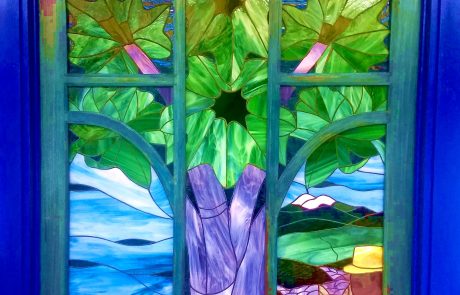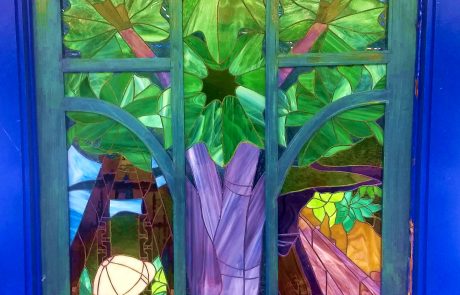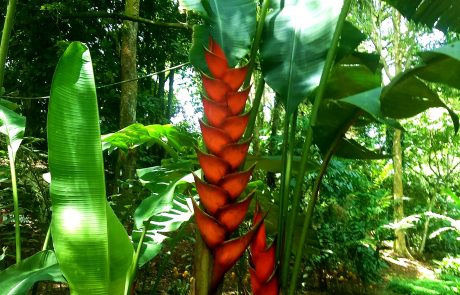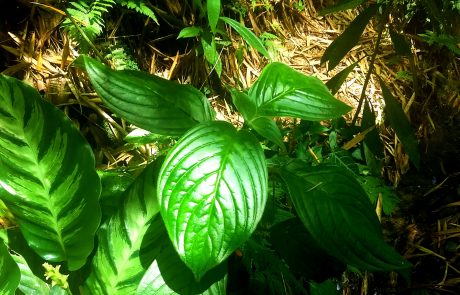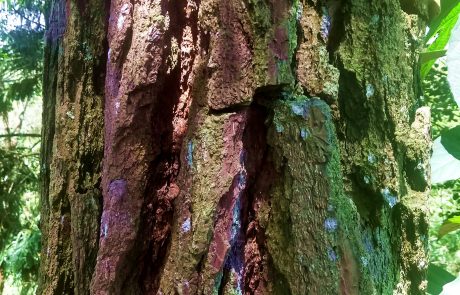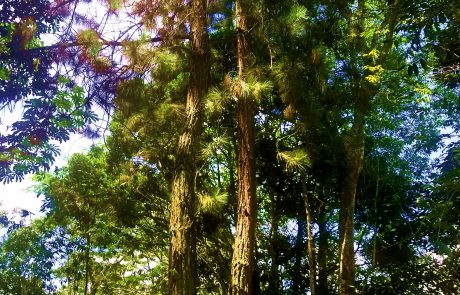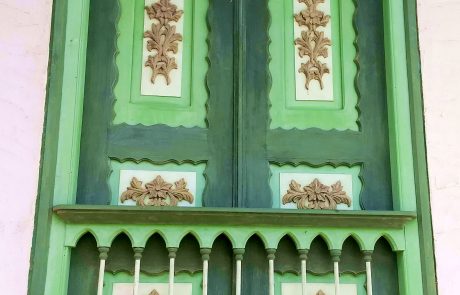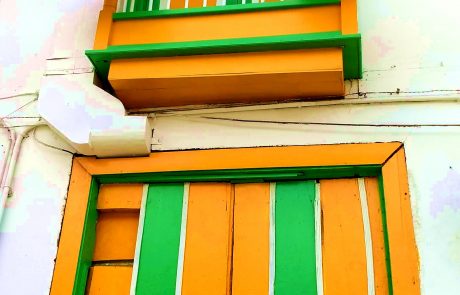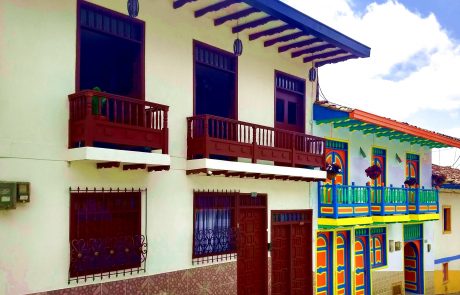July 2019
 Marsella is only about an hour northwest of Pereira but it’s a world away in atmosphere. The trip takes you through the heart of Coffee Country and you end up in a charming town that seems from a bygone era, although all the comings and goings of modern life are amply evident, as well. Before coming to the Coffee Triangle I had come across some YouTube videos of Marsella — the municipality has done one promoting it as a tourist destination and a few people have done videoblogs of visits there (in Spanish, I hasten to add, nothing in English). I thought I had a fairly good idea of what Marsella would be like but I was wrong, dead wrong. It leaves me feeling a bit silly to come away from my own visit with so different (and so much better) an impression of Marsella than I expected to have based on what I saw beforehand. But that’s life, there are surprises round every corner. This was one of the good ones and I have Marsella on my short list of favorite hangouts in the Coffee Triangle region for more than one reason.
Marsella is only about an hour northwest of Pereira but it’s a world away in atmosphere. The trip takes you through the heart of Coffee Country and you end up in a charming town that seems from a bygone era, although all the comings and goings of modern life are amply evident, as well. Before coming to the Coffee Triangle I had come across some YouTube videos of Marsella — the municipality has done one promoting it as a tourist destination and a few people have done videoblogs of visits there (in Spanish, I hasten to add, nothing in English). I thought I had a fairly good idea of what Marsella would be like but I was wrong, dead wrong. It leaves me feeling a bit silly to come away from my own visit with so different (and so much better) an impression of Marsella than I expected to have based on what I saw beforehand. But that’s life, there are surprises round every corner. This was one of the good ones and I have Marsella on my short list of favorite hangouts in the Coffee Triangle region for more than one reason.
I learned yesterday that a Colombian telenovela (read: soap opera for evening broadcast) was filmed in Marsella. Of course it was set in a historical period — that’s almost a given when Marsella’s antique charm is taken into account. But it’s not a museum town like Filandia, on which I pronounced assessment in my previous post. Marsella is very much a town of the present despite its historical architecture. It has a modern feel to it, not an antiquey feel, and it’s clear that people are quite busy going about their modern business of raising coffee and other agricultural products, fixing machinery, buying groceries and all the things we do in modern life. I found that modernism refreshing and perfectly consonant with the historical grace the town has. It’s an excellent blending of the old with the new and works a treat.
I’m going to use the freedom writing affords to violate the chronological order of the pics I took so you can get a view of the countryside between Pereira and Marsella. I took the pics on the return trip, not going up, but if I hadn’t told you’d never have known, right? So pretend we’re on the trip from Pereira up to Marsella and we’re having a look at the landscape at the heart of the Coffee Triangle. It’s gorgeous and surprising in more than one way:
Pereira is at an altitude of 4,629 ft. above sea-level. Marsella sits at 5,167 ft. That’s not a big difference but the road between the two places would lead you to believe you’ve increased altitude by twice that amount. The small, two-lane road is an almost uninterrupted series of switchback curves going up, up and away. The vistas the curves provide over the landscape are breathtaking, as I hope the pictures above manage to show. I’d have been quite content to spend the morning stopping at the few turnouts affording lovely views to look at the mountains as they reveal increasing intensity in the cultivation of coffee and bananas.
I had no idea that coffee was planted on such steep ground. Some of the plantings I saw were at such a pitch I can’t imagine how on earth harvesters manage to keep their footing without cletes on their shoes and rappel lines to hold them from tumbling headlong to the bottom of the slope. If I were Juan Valdez and somebody told me I was going to fill that big basket on my back to the brim with coffee berries on such a steep incline my response would be, “You’re joking, right? RIGHT??” I don’t know how they do it but obviously they do since there stand the coffee bushes in all their glory and somebody’s got to get the berries off them so we can buy Colombian Supremo in Safeway. I saw nobody in the fields during either the up or the down trip, so the modus operandi remains a complete mystery to me. Probably just as well, the reality would only further increase my sense of alarm at the prospect of doing anything at such an angle.
The entrance to Marsella is very low-key — a road comes into town and follows its eastern edge going past things like car repair shops and places to buy chicken feed. Then all of a sudden the show begins:

I’m no art expert but I’m smart enough to figure out that we’re getting a pictorial history of the town from somebody with a lively imagination and a decent sense of design. We start at the left with Quimbaya people, then comes the coffee plant, then come two things I’m at pains to identify, and we end up on the right with the town sporting its fine church. Painless history done right. 🙂
You have to make a left off the main road and go up some steepnesses to get to the town square. Everywhere in the Coffee Triangle you have to go up or down steepnesses to get anywhere at all. It’s part of the charm. Just make sure you remember to put on your emergency brake if you have to stop at an intersection when the car is pitched at an angle of 45 degrees and all will be well. Without further ado I let the handsomeness of Marsella’s town square speak for itself:
It’s not difficult to see why a period telenovela was filmed in Marsella — it ticks all the boxes. Clear out the locals of an afternoon, put vintage clothes on the actors and you’re good to go without fuss or bother. The day of my visit was in the middle of the week so things were relatively calm. There were local people sitting at the tables of the sidewalk cafes enjoying a coffee — exactly as I did with a piece of yummy carrot cake (evidence of ubiquitous American influence, no doubt LOL). The biggest surprise of my people watching from the cafe table was to see two fine young fellows clop past on beautiful paso fino horses doing the high step. I know it wasn’t staged but the director of a period telenovela would immediately swing the camera in their direction for a spot of visual authenticity. Marsella wears his historicality lightly but it fits like a glove.
The church is a fine example of its kind in the small towns of Colombia. All the town churches I’ve seen follow the basilica structure handed down to us by the Romans. There’s a high central nave and two side aisles at about half the elevation, sometimes with side chapels sometimes not. Sometimes the nave has a dome, sometimes not. Different strokes for different folks, right? Here’s a pic of the church interior:
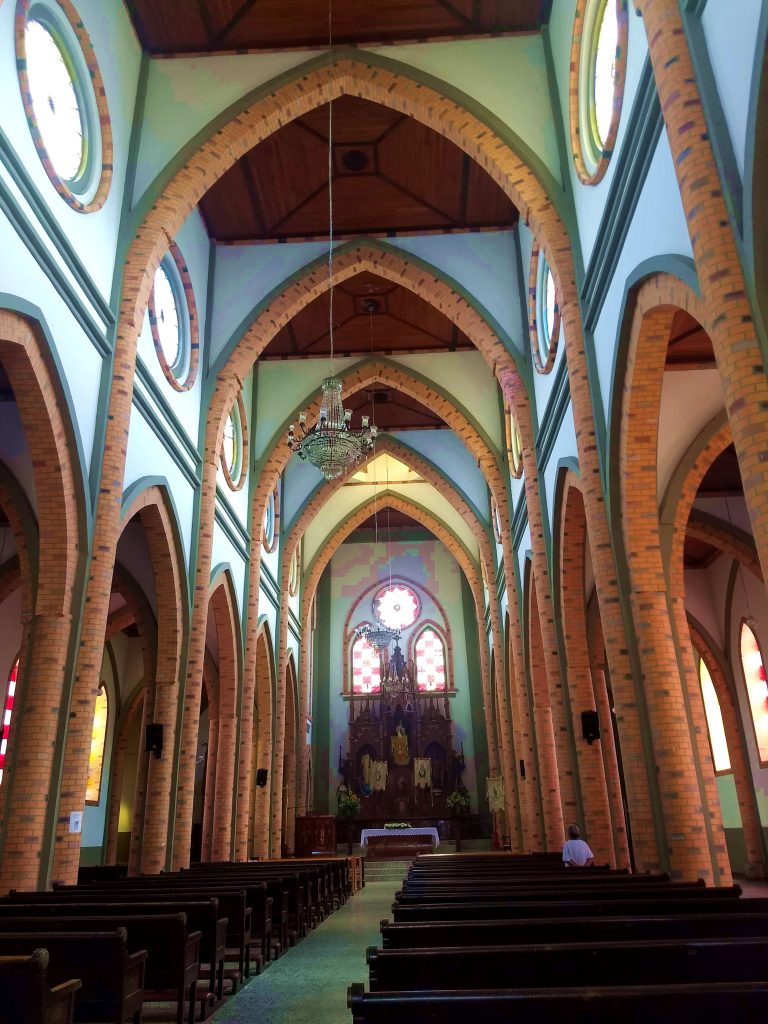
The same honey-cake colored brick is used for the interior that you see in the exterior, an architectural approach I find quite sensible and satisfying at the same time. I think it’s a fine example of ecclesiastical architecture done well and I enjoyed sitting in the quiet with the few other people inside. (I was going to write old people since we were all in the geriatric set, but hey, age is just a number, RIGHT?)
You don’t have to wander more than two short blocks from the town square until you reach the west edge of town. So within two minutes of strolling from the town square with all its architectural delights you’re back looking at good old Mother Nature, as these pics show:
The first pic has our plant friend front and center because it gave me a thrill up and down the spine. It’s a cycad, something I’ve only ever seen in plant conservatories and here it sits, out in broad daylight in front of God and everybody. BIG DEAL for this denizen of the Bitter North. Marsella thinks of itself as historical but the cycad sitting on its edge makes that claim so wholly relevant it stretches truth to its limit. Why? Let’s have Wikipedia inform us from the page on cycads (here):
The cycad fossil record dates to the early Permian, 280 million years ago (mya). There is controversy over older cycad fossils that date to the late Carboniferous period, 300–325 mya. This clade probably diversified extensively within its first few million years, although the extent to which it radiated is unknown because relatively few fossil specimens have been found. The regions to which cycads are restricted probably indicate their former distribution in Pangea before the supercontinents Laurasia and Gondwana separated. Recent studies have indicated the common perception of existing cycad species as living fossils is largely misplaced, with only Bowenia dating to the Cretaceous or earlier. Although the cycad lineage itself is ancient, most extant species have evolved in the last 12 million years.
Marsella was founded in 1860. Let’s see … 280 million minus 1860 equals 279,998,140 — whose kazillion-great-granddaddy gets the prize? We’re lookin’ at you, Greenie, old pal. You take the cake.
After having lived for two years on the coastal plain of Panay Island in the Philippines — as flat as the proverbial pancake — I take continual and unabated delight in the verticality of the landscape. I come from mountain country and mountains are in my blood. I feel at home in the Coffee Triangle where mountains are absolutely the rule without exception. There’s barely a spot of flat land to be had — and it’s all good with me.
One of the main claims to fame in Marsella is La Casa de la Cultura (= The House of Culture). Many towns of the Coffee Triangle have one — Filandia, for example, as I described in my last post — but the one in Marsella is a Big Deal. I’ll show the pics first and do the talking later.
The first pic of the Hymn to Marsella comes from the mayor’s office across the street from the Casa de la Cultura. It’s the usual stuff about hearth and home and flags waving in freedom and plenty. You know the story. How free and prosperous things are in Marsella would take a good deal longer than a day to find out, so I’ll leave that for other fingers to type up.
As you can see, the building itself is on rather a grand scale for a town of some 14,000 inhabitants. Three arcaded stories around an impressive open courtyard, quite in the Spanish style, as things are wont to be in Colombia for obvious reasons. It’s done entirely in wood and while showing its age it does so in a suitably historical fashion, being in quite good nick. As for the contents, well … let’s not beat around the bush. If you come from Marsella you may very well find it edifying to see the first typewriter that came to town and belonged to Don Whooziwhatsit. If you’re a tourist from across the seas the effect is rather different. There were, however, a few things that arrested my attention, including the notice about the “Bandas Femininas,” i.e. girl bands who formed an important element of town culture back in the day. Let’s hear it for girl power, yeehaw. I hope that tradition has continued unabated up to the present day — if not through music, then through other appropriate cultural means of transmission — e.g., the strategic brandishing of frying pans when male reticence toward doing chores in a timely fashion rears its ugly head.
On the third floor is one room — yes, one room out of three floors of rooms — devoted to pre-Columbian artefacts. Even calling them “pre-Columbian” implies linguistically that they date from a time before Reality intervened in local affairs. As if. The artefacts are Quimbaya in origin, but as in Filandia they’re exhibited without date or provenance. They could have been tossed off the wheel of a potter down the road and I’d be none the wiser. These things evoke a great sadness in me and I walked through the room quickly without lingering. The objects themselves are depressing because they bespeak an existence hard enough pressed before the arrival of the Spanish. Some of the household items are of such ungainly shape and poor craftsmanship they appear hollowed out and patted down from lumps of clay dropped on the ground. There’s a history to be told about the Quimbaya, I know, but I’ll never learn it from such displays. That fact only increases the sadness and drives me out of the room even more quickly.
Just next to the sad room you find these delightful panels of stained-glass work in a series of windows giving onto a large (and empty) exhibition room. They have absolutely no historical significance, in fact they could easily have come from a workshop in Seattle or Portland. But they’re lovely and I wanted to share them. You can see from the pic of their reverse side how delightful they are when the light comes through them.
The first pic in the second row is my idea of the PERFECT study. If I had such a room with such a view I’m sure, absolutely sure I’d write the Great American Novel within six months. I’d be forced to it by such a lovely space with such a lovely outlook over such beautiful countryside. Obviously it would have to be some Jane Austen kind of thing, not a crime thriller about the drug trade in Marseilles (after which, by the way, Marsella is named). I can just picture Mr. Darcy in a light drizzle walking swiftly past the mural coming into town while on his way to find What’s Her Face (the name escapes me at the moment) as she trundles across the coffee fields. Upon meeting they don’t kiss, they say “Good To The Last Drop.” 🙂 I know, I know … don’t quit your day job, RIGHT?
Botanical gardens seem to be all the rage in small towns in the Coffee Triangle and Marsella is no exception. Apparently the municipal government has become a bit stingy with the funding, hence things are a bit lower-key than by right they should be. It’s a lovely place and I enjoyed walking through it, but I was the only soul about. I fear that’s all too often the case, which means things are a bit helter-skelter here and there with regard to maintenance and labeling. All the same, a botanical garden is not to be missed if you’re on my page and I’m glad I took in Marsella’s with full attention. Here are some of the treasures I found:
The second pic in the top row deserves special mention. The flowers you see resting on the leaves fell from WAY up above in a treetop just beside the plant in the pic. It’s a species of Tabebuia. When I craned my neck back to look up at the crown of the tree I saw it covered in such gorgeous flowers. Tabebuia is a species used often as an ornamental in Brazil — the reason is obvious. What a delight.
In the bottom row we have a pine, things being cool enough up this high to support the preferences of our pine friends. This particular species is Pinus patula, commonly known as Mexican Weeping Pine. I didn’t hear any sobs while I was around it, but maybe it was just a good day, who knows. It’s a foreigner like me, not a native. But we foreigners have our place in creation, too, and our pine friend cuts a very handsome figure in the Colombian botanical garden where it holds forth. It just goes to show that good things can indeed cross oceans (provided they don’t come from Spain bearing arms).
To close I offer a gallery of bits and bobs from my wanderings around the town. The architectural details are fascinating and the inhabitants have a wonderful sense for enhancing their architecture with flowers. It makes for a stroller’s delight par excellence.
Marsella turned out to be more than half again the delight I expected. It just goes to show that you can’t trust videobloggers to get all the details. Where were the shots of the gorgeous countryside? Where the architectural treats? I hope I’ve managed to avoid such pitfalls in this post and do justice to the loveliness Marsella offers its visitors. I’ll be going back for more of it, you can be sure of that. After a look at my parting shot, you’ll need no explanation about my reason for wanting to return.



